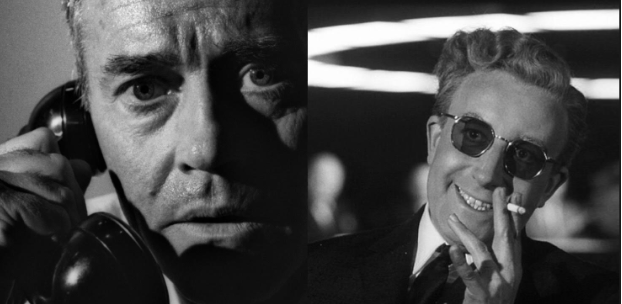Written By: Patrick Novak, Staff Writer
EXTINCTION: Stanley Kubrick and Sidney Lumet explore diverging perspectives of nuclear destruction.
At the height of the Cold War, fear of nuclear annihilation was ever present. Shortly after the Cuban Missile Crisis, Stanley Kubrick and Sidney Lumet both released movies based off of books in the same year, with each film centering around nearly identical premises about an accidental American nuclear attack on the Soviet Union. Despite having similar stories, they differ heavily in tone. Kubrick’s movie Dr. Strangelove or: How I Learned to Stop Worrying and Love the Bomb is a comedy, while Lumet’s Fail Safe is a drama. Both films represent America’s differing perspectives of nuclear destruction.
Where Dr. Strangelove finds humor in nuclear war. Fail Safe reveals horror. The catalyst of the attack in Strangelove being human error, and Fail Safe being a mechanical malfunction. Both possibilities being completely plausible at the time; the end of the world being directly caused by a human or a machine.
The cinematography of both films highlight the intense situation in different ways with the same striking effect. Both films were purposely shot in black and white to produce that effect. Fail Safe having a very high contrast ratio with dramatic lighting to emphasize the moral gray area that everyone is caught in, as well as the lack of control the people have in this situation. The shot composition in both films emphasize power and equity in various ways. Such as the use of upward angles of General Jack Ripper in Dr. Strangelove which emphasizes the power he holds. The dynamic between Professor Groeteschele and General Black is communicated very effectively in various ways due to both the clever filmmaking techniques and incredible performances from Walter Matthau and Dan O’Herlihy. General Black is always seen with an intense feeling of grief and tiredness showing how tired he is from war as an experienced soldier. His feelings of exhaustion in combination with his well-decorated uniform tell the audience everything about his past and the way he feels now. This is a powerful contrast to Professor Groeteschele who has an aggressive stance on their situation due to his expertise in foreign relations and his lack of first hand experience in war. He is also wearing a suit in the entire movie which emphasizes how out of place he is in a setting of people in military uniforms as well as how much experience he lacks. The character’s body language adds an extra element to understanding of his character. He is often standing up looking down on General Black making himself appear more powerful in comparison to the General. Despite Groeteschele’s powerful appearance paired with his lack of experience, and Black’s fatigued demeanor and decorated uniform, they are both unable to control the situation.
However, despite being a comedy there is a great deal of dread in Dr. Strangelove. American troops are sent to the military base to stop an out of control general from ordering attacks on the Soviet Union. This shows how America had been at war with itself over the use of nuclear weapons. There is a similar scenario played out in Fail Safe when American fighter pilots are sent to kill other American pilots headed to drop bombs on Moscow. No amount of comedy can suppress the intense feeling of dread that the inevitability of total nuclear annihilation brings. The last moments of Strangelove are a perfect example of this.
Despite differing heavily in tone, both Dr. Strangelove and Fail Safe succeed at capturing the constant looming dread of mass destruction. The comedic and dramatic nature of the two films perfectly represent the cultural attitude towards nuclear warfare.

